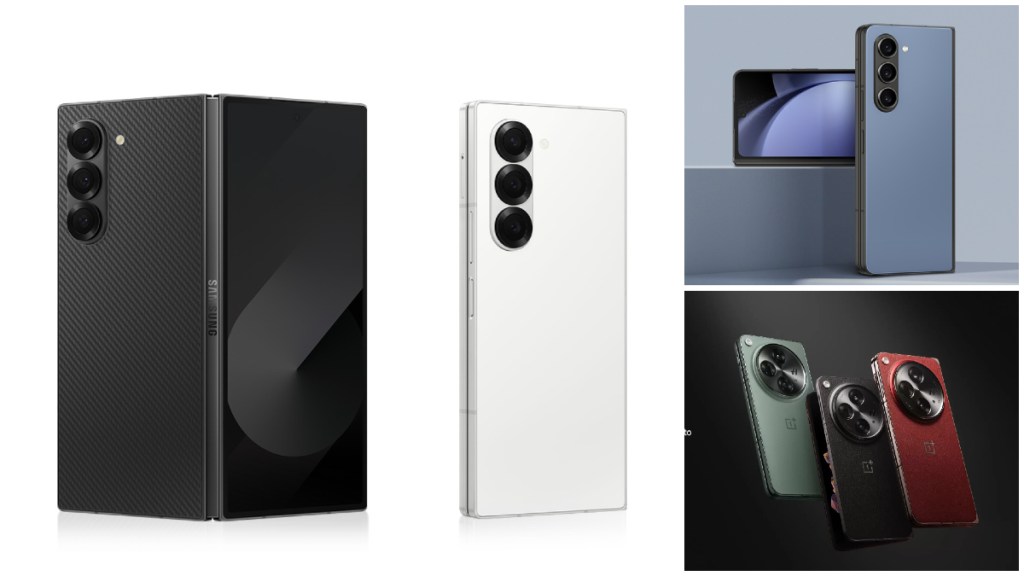With Samsung breaching the 2 lakhs price mark with its latest foldable, there’s more reason to dissect it with a bigger probing lens than ever before. On the surface, it seems not a lot has changed. You can say that Samsung really pushed the boundaries with the Fold 5, when it finally closed the gap with new and upcoming competition, and so, there was very little it could do to make the Fold 6 stand out at least from a hardware perspective.
No wonder, all the communication has shifted to Galaxy AI, this year. The Fold 6 does come with a fair share of groundbreaking generative AI quirks, but do they justify the price bump, especially considering that competition has started to catch up and offering at par foldable experience, if not better, at lower prices. We’re of course talking about the OnePlus Open that took the market by storm and while reports suggest OnePlus may not launch a successor anytime soon, at least it showed Samsung the mirror in many ways.
With Google also set to enter the foldable fray in India soon, competition is going to get fiercer. We will have more to say about the Pixel 9 Pro Fold in the days to come, for now, here’s a quick lowdown of how the Fold 6 stacks up against its predecessor and even more importantly, the OnePlus Open. Let’s get started.
Samsung Galaxy Z Fold 6 versus Fold 5, OnePlus Open:
- Build, thickness: According to paper specs, the Fold 6 uses the same build materials as the Fold 5— Corning Gorilla Glass Victus 2 on the front and back and aluminum on the side. The folding display obviously has the element of plastic. But there seems to be some inner refinements which have led to a more compact overall chassis. The Fold 6 is significantly lighter than the Fold 5—239g versus 253g. The change brings it at par with the OnePlus Open. The Open has a version with faux leather back that is also 239g. That’s in addition to the glass variant, which is a bit heavier at 245g, understandably so. The Fold 6 is also thinner than the Fold 5—12.1mm versus 13.4mm when folded. The Open is the thinnest though measuring only 11.7mm in folded state (despite having a bigger screen might we add. Compared to the Fold 5, the Fold 6 is boxier with straight lines, reminiscent of the S24 series phones. Another improvement in the Fold 6 is that it gets dust resistance which is missing on the Fold 5. The Fold 6 is IP48 rated. The Fold 5 is rated IPX8. The OnePlus Open lacks any ingress protection whatsoever. OnePlus doesn’t specify the glass type either.
- Display(s): On paper, the OnePlus Open has bigger, brighter screens. That is, 7.82-inch 2K (2440x2268p) LTPO AMOLED on the inside with a maximum refresh rate of 120Hz. It can go up to 2,600nits. While on the outside, it has a 6.31-inch 2K (2484x1116p) LTPO AMOLED, also 120Hz and with 2,800nits peak. OnePlus uses the term “ceramic guard” for the cover screen’s protective material. The Fold 6 has a 7.6-inch 1856x2160p (QXGA+) LTPO AMOLED inner folding display with a maximum refresh rate of 120Hz and peak brightness of 2,600nits. Except for the enhanced brightness (versus 1,750nits), the specs are like the Fold 5’s. The Fold 6 has a slightly bigger cover screen at 6.3-inch (versus Fold 5’s 6.2). Its LTPO AMOLED can also go as low as 1Hz (120Hz maximum) whereas the Fold 5’s could hit only 48Hz at the lowest. The resolution is 968x2376p (HD+) and peak brightness is 2,600nits. Compared to the Fold 5’d (23.1:9), it has a more usable 22.1:9 aspect ratio. The OnePlus Open has the best cover screen implementation with its 20:09 aspect ratio.
- Processor, memory: The OnePlus Open hardware is more akin to Fold 5’s— both rock the Qualcomm Snapdragon 8 Gen 2. The Fold 6, being a newer model, has the latest Qualcomm Snapdragon 8 Gen 3. OnePlus offers the Open in sole 16GB/512GB memory configuration. The Fold 6 comes in a choice of 12GB/256GB, 12GB/512GB and 12GB/1TB. The Fold 5 is also available in the same configurations.
- Software support: The Fold 6 leads the pack here with a guarantee of seven years of Android and security updates. It comes with Android 14 out of the box. The OnePlus Open is good for only four years of Android and five years of security updates.
- Cameras: The Fold 6’s cameras are the same as the Fold 5’s which means a trio of sensors on the back: a 50MP main, 12MP ultrawide, and another 10MP 3x telephoto. The folding display has a 4MP camera below the screen while the cover screen on the front has another 10MP shooter. The OnePlus Open’s camera setup includes a 48MP main, another 48MP ultrawide, and a 64MP 3x telephoto. The folding display has a 20MP camera while the cover screen on the front has another 32MP shooter.
- Battery, charging: The OnePlus Open has the biggest battery of the lot at 4,805mAh (versus 4,400mAh in both Fold 6 and Fold 5). It also supports faster 67W wired charging (versus 25W in both Fold 6 and Fold 5). The Fold 6 additionally supports 15W wireless charging as well as reverse wireless charging, same as the Fold 5.
- Connectivity: The Fold 6 and Fold 5 both have a USB Type-C 3.2 port (versus USB Type-C 3.1 in the Open) and Ultra Wideband (UWB) support.
- India prices: The Fold 6 is the priciest foldable among the current batch. It is priced at Rs 1,64,999 for 12GB/256GB, Rs 1,76,999 for 12GB/512GB and Rs 2,00,999 for 12GB/1TB). The Fold 5 launched at Rs 1,54,999 for 12GB/256GB, Rs 1,64,999 for 12GB/256GB and Rs 1,84,999 for 12GB/1TB. The OnePlus Open is most affordable coming in at Rs 1,39,999 for 16GB/512GB.








